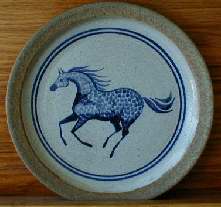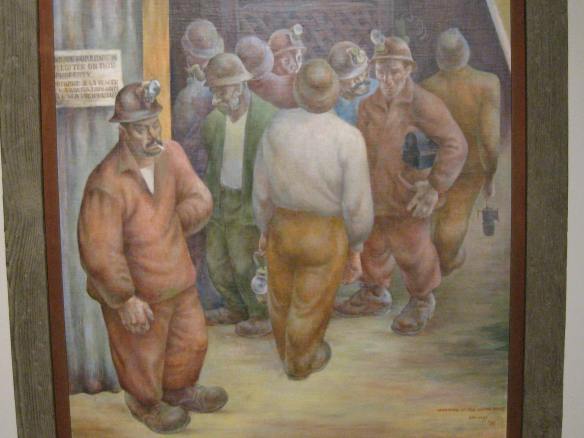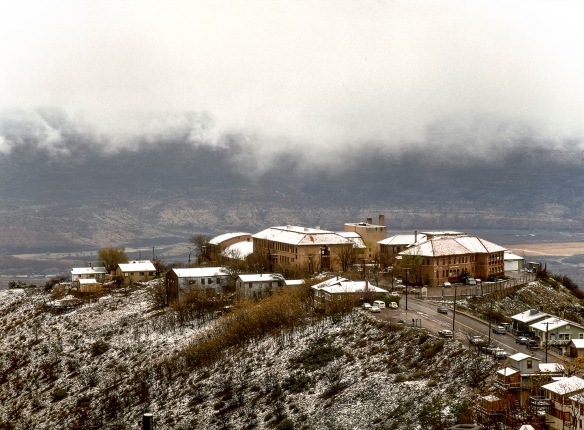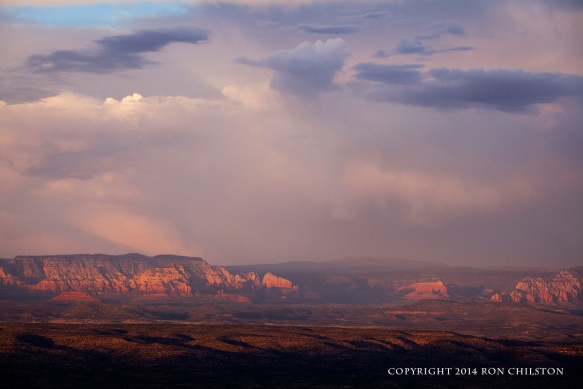The major reason Jerome is an unusual art mecca is because its resident artists are deeply entwined in the collective identity of the town. Artists are the heart of the town’s quirky, and sometimes contentious, soulfulness.
Since 1970, the annual ratio of artists to residents has averaged 25%—at least 100 out of 400 or so of its permanent residents. Few other art towns/cities can claim that high a percentage. Artists nourish and encourage each other, giving rise to a feedback loop that challenges them to improve and flourish.
Artists in Jerome Arizona are Business People
Many artists own successful shops and galleries. They help disprove clichés that artists should starve for the sake of their art and aren’t cut out to be business people. The oldest of the uptown galleries is Made in Jerome, co-founded in 1972 by potter David Hall and two students from Prescott College who were eventually bought out by Hall. Others artist-owned galleries and shops in the main part of town include Nellie Bly II (painter Diane Geoghegan) www.dianegeoghegan.com, Aurum Jewelry (co-owner artist Sharon Watson) www.aurumjewelry.com, Raku Gallery (glass blower and potter Tracy Weisel www.Rakugallery.com, Designs on You (owned by Leigh Hay Martin, a gifted quilter) www.designsonyoujeromeaz.com, and Caduceus Cellars (owned by noted vintner and rock star Maynard Keenan) www.caduceus.org. Artists own and operate all the studio businesses in the high school complex.

Jane Moore’s paintings on pottery, available at Made in Jerome, are famous and very lovely. (www.madeinjerome.com)
Jerome Arizona Artists Participate in Politics
Even more unusual is that many Jerome artists participate in politics. In a town that has at least 110 volunteer positions, artists quickly learned that if they wanted a say in the safety, restoration and future of the town, they needed to actively involve themselves. Artists helped draft Jerome’s Comprehensive Plan and Zoning and Design Review ordinances. Artist have been elected to the Jerome Town Council and appointed to serve on Planning and Zoning and Design Review; voted by members of the Jerome Historical Society to serve as board members; and served on the Jerome Fire Department and fire auxiliary. Their contributions help counter the oft-spoken opinions that the hippies that moved to Jerome were spaced out, stoned-out good for nothings and that artists shouldn’t meddle in politics.
Painter Anne Bassett who has served multiple time on the Jerome Town Council said, “People who don’t protect their liberty, lose it. I’ve tried to protect against the developers and further the respect for Jerome’s historic elements. From the beginning of when hippies moved in and became the majority, we have been working against the mainstream. Our high appreciation for diversity is a unifying strength. I’m still a hippie and proud of it.”

The DeCamp house on Company Hill in Jerome AZ. It sits on the edge of Paradise Lane. Illustration by Anne Bassett (www.jeromeartistannebassett.com/
Jerome Arizona Artists Donate Generously to Benefits
Musicians and artists have raised tens of thousands of dollars in the last few decades by donating services and art for benefiting Jeromans who are sick and needy or to organizations like the library, humane society and fire department. They also donate generously to the Children’s Christmas party every year to ensure there are gifts for every child in Jerome. Thank you artists!
Organization of the Community of Jerome Artists
Just after big mining abandoned Jerome in 1953, the first artists that moved in organized to support each other and draw attention to Jerome art. Roger Holt who had exhibited at the Metropolitan Museum of Art, Corcoran Gallery, and Carnegie Institute moved to Jerome in 1954 and lived there until the mid-1960s. Shan Holt, his wife, started a group called The Verde Valley Artists. Shan found a patron and friend in portrait artist, Lilli Brant, who became president of the group. As the town struggled to survive, Lilli’s husband, the renowned geophysicist Arthur Brant, predicted that someday Jerome would become an art destination.
In 1975, The Verde Valley Artist group morphed into a formal nonprofit called the Verde Valley Artists Association (VVAA), which started featuring non-Jerome artists for major Jerome exhibitions. One featured Paolo Soleri, the Italian architect who built the futuristic desert city Arcosanti, which was based on the fusion of architecture and ecology, which Soleri termed arcology. Another show featured Lew Davis, dean of Arizona artists, who grew up in Jerome during its mining days.

“Morning at the Little Daisy,” by Lew Davis, owned by the Phoenix Art Museum. Davis grew up in Jerome, not wanting to admit to wanting to be an artist in a community of miners. After he moved out of Jerome, Davis painted a series of paintings depicting life in Jerome.
The VVAA began a student art show that toured the state and sponsored studio tours. Many artists reported they sold their first pieces of art to people attending those tours.
These activities garnered support from many Verde Valley businesses, which had been standoffish and suspicious of Jerome’s hippies and helped place Jerome on the map as an art destination.
Support of Arts by the Jerome Community
From 1953 forward, the community of Jerome has actively supported the artists. The Jerome Historical Society donated the space to the Verde Valley Artists and rented space to other artists at very low costs; and voted some of their income to buy art, as did the town of Jerome. Both the society and the town have extensive and valuable art collections, as do many of its residents and businesses.
Paul Handverger, a board member of Verde Exploration Ltd. (Verde Ex), helped persuade them to purchase Mingus Union High School in 1972 for $25,000 and target artists as renters. The first renter was fine arts painter Jim Rome, who had a gallery uptown and a large following. Clothing designer Ava Guitterez was second and she eventually opened a shop on Main Street. Artists Margo Mandette and Robin Anderson turned one of the buildings into a showpiece gallery and studio. Don Bassett, an artist who made humorous assemblages from iron scrap and bedsprings, was given a small apartment and free rent in exchange for being caretaker.

What used to be a high school is now an art focal point in Jerome AZ. Photo by Bob Swanson (Swansonimages.com)
Last but not least, the town’s aesthetics draw artists to it like bees to honey, just as they were drawn to other towns with exceptional aesthetics, such as Sedona, Taos, New Mexico and San Miguel de Allende, Mexico. Few other art towns, however, command the spectacular 180-mile panorama view that Jerome has from its steep mountain perch.
Note: My book, Home Sweet Jerome, is about how artists and hippies transformed the town from being an economically depressed ghost town into the art mecca that it is. This blog is just a summary of some of the highlight themes. The book is availabe from Amazon at an incredible discount right now (https://www.amazon.com/Home-Sweet-Jerome-Rebirth-Arizonas/dp/1555664547/ref=sr_1_1?ie=UTF8&qid=1469982014&sr=8-1&keywords=home+Sweet+jerome

Views from Jerome, AZ are often subjects of photographers and painters, only one of the reasons it is the most photographed and painted town in America. Photo by Ron Chilston (www.ron-chilstonartistwebsites.com)
